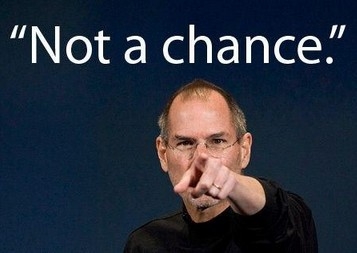The company had not only a new logo, but a new name. No longer was it Next. It was NeXT. Others might not have understood the need to obsess over a logo, much less pay $100,000 for one. But for Jobs it meant that NeXT was starting life with a world-class feel and identity, even if it hadn’t yet designed its first product. As Markkula had taught him, a great company must be able to impute its values from the first impression it makes.
公司现在不仅有了新的标识,还有了个新名字。它不再叫Next,而变成了NeXT。其他人也许还不明白重视标识的必要,更不会为了一个标识花上10万美元。但对于乔布斯来说,一个好的标识意味着NeXT正在以世界级的感觉和身份起步,尽管它还没有设计出自己的第一款产品。马库拉曾教过他,你可以根据封面去评价一本书,而一家伟大的公司必须从给人的第一印象就映射出自己的价值观。从这一点来看,这个标识简直酷毙了。
As a bonus, Rand agreed to design a personal calling card for Jobs. He came up with a colorful type treatment, which Jobs liked, but they ended up having a lengthy and heated disagreement about the placement of the period after the “P” in Steven P. Jobs. Rand had placed the period to the right of the “P.”, as it would appear if set in lead type. Steve preferred the period to be nudged to the left, under the curve of the “P.”, as is possible with digital typography. “It was a fairly large argument about something relatively small,” Susan Kare recalled. On this one Jobs prevailed.
作为免费赠品,兰德同意为乔布斯设计个人名片。兰德想出了一个颜色丰富的解决方案,乔布斯很喜欢;但是在“SteveP.Jobs”这个名字中字母P后面的缩写符位置问题上,两人产生了长久而激烈的分歧。兰德想把缩写符的位置靠右放一点儿,这样用铅字印刷的时候,这个符号就会比较清晰。史蒂夫比较喜欢缩写符离P更近一点儿,就放在“P”的曲线下,比较适合数字排版。“就这样,一件小事情引发了非常大的争论。”苏珊·卡雷回忆道。这一次,乔布斯占了上风。
In order to translate the NeXT logo into the look of real products, Jobs needed an industrial designer he trusted. He talked to a few possibilities, but none of them impressed him as much as the wild Bavarian he had imported to Apple: Hartmut Esslinger, whose frogdesign had set up shop in Silicon Valley and who, thanks to Jobs, had a lucrative contract with Apple. Getting IBM to permit Paul Rand to do work for NeXT was a small miracle willed into existence by Jobs’s belief that reality can be distorted. But that was a snap compared to the likelihood that he could convince Apple to permit Esslinger to work for NeXT.
为了将NeXT标识完全体现在真实的产品中,乔布斯需要一位值得信任的工业设计师。他和几位可能的人选谈了谈,但是没有人比他推荐给苹果公司的巴伐利亚狂人哈特穆特·艾斯林格更合适。艾斯林格的青蛙设计公司在眭谷设有工作室,由于乔布斯的缘故,斯林格和苹果公司签订了合同,收入颇丰。说服IBM公司允许保罗·兰德为自己设计NeXT标识,是乔布斯相信现实能被意志扭曲的一次小小奇迹。然而,与接下来说服苹果允许艾斯林格为NeXT工作相比,这要算是很容易的事情了。
This did not keep Jobs from trying. At the beginning of November 1985, just five weeks after Apple filed suit against him, Jobs wrote to Eisenstat and asked for a dispensation. “I spoke with Hartmut Esslinger this weekend and he suggested I write you a note expressing why I wish to work with him and frogdesign on the new products for NeXT,” he said. Astonishingly, Jobs’s argument was that he did not know what Apple had in the works, but Esslinger did. “NeXT has no knowledge as to the current or future directions of Apple’s product designs, nor do other design firms we might deal with, so it is possible to inadvertently design similar looking products. It is in both Apple’s and NeXT’s best interest to rely on Hartmut’s professionalism to make sure this does not occur.” Eisenstat recalled being flabbergasted by Jobs’s audacity, and he replied curtly. “I have previously expressed my concern on behalf of Apple that you are engaged in a business course which involves your utilization of Apple’s confidential business information,” he wrote. “Your letter does not alleviate my concern in any way. In fact it heightens my concern because it states that you have ‘no knowledge as to the current or future directions of Apple’s product designs,’ a statement which is not true.” What made the request all the more astonishing to Eisenstat was that it was Jobs who, just a year earlier, had forced frogdesign to abandon its work on Wozniak’s remote control device.
但这并没有阻止乔布斯去尝试。1985年11月初,苹果对乔布斯提起诉讼5周后,乔布斯就写信给艾森斯塔特(苹果公司法律总顾问,诉讼由他发起),要求取消诉讼。“我这周同哈特穆特·艾斯林格聊过,他建议我给你写一封信,表达我想同他及青眭设计公司合作NeXT新产品的原因。”乔布斯写道。令人惊讶是,乔布斯的说法是,他自己不知道苹果公司正在做的东西,但是艾斯林格知道。“NeXT对于苹果公司产品设计现在和未来的方向都一无所知。如果我们和其他那些同样对苹果不了解的设计公司合作的话,那就有可能会不经意地设计出外观类似的产品。而哈特穆特他们了解苹果,能够确保不会让设计与苹果的产品类似,因此这对苹果公司和NeXT公司都最有利。”艾森斯塔特回忆,自己为乔布斯的厚颜无耻瞠目结舌,他对此作出了简短的回复。“我曾代表苹果公司表达过担忧,你所从事的业务会利用苹果公司的机密商业信息。”他写道,“你的信函无论如何无法减轻我的忧虑。事实上,它加深了我的担忧,因为你在信中表示自己‘对苹果公司产品设计现在和未来的方向一无所知’,而这一说法并非事实。”更令艾森斯塔特惊讶的地方在于,就在一年前,乔布斯本人就曾强迫青蛙设计公司放弃沃兹尼亚克遥控装置的项目。
Jobs realized that in order to work with Esslinger (and for a variety of other reasons), it would be necessary to resolve the lawsuit that Apple had filed. Fortunately Sculley was willing. In January 1986 they reached an out-of-court agreement involving no financial damages. In return for Apple’s dropping its suit, NeXT agreed to a variety of restrictions: Its product would be marketed as a high-end workstation, it would be sold directly to colleges and universities, and it would not ship before March 1987. Apple also insisted that the NeXT machine “not use an operating system compatible with the Macintosh,” though it could be argued that Apple would have been better served by insisting on just the opposite.
乔布斯意识到,为了同艾斯林格合作(以及各种其他原因),必须解决苹果公司的诉讼。幸运的是,斯卡利愿意考虑撤销诉讼。1986年1月,他们达成庭外和解,不涉及经济损失。为了回报苹果公司放弃诉讼,NeXT公司同意了种种限制条款:其产品将作为髙端智能终端直接销售给髙校,而且NeXT公司不能在1987年3月之前推出产品。苹果公司还坚持,NeXT的机器“不能使用与麦金塔兼容的操作系统”。后来的情况表明,如果当时苹果公司的要求刚好相反,会对自身更为有利。
After the settlement Jobs continued to court Esslinger until the designer decided to wind down his contract with Apple. That allowed frogdesign to work with NeXT at the end of 1986. Esslinger insisted on having free rein, just as Paul Rand had. “Sometimes you have to use a big stick with Steve,” he said. Like Rand, Esslinger was an artist, so Jobs was willing to grant him indulgences he denied other mortals.
诉讼解决后,乔布斯继续游说艾斯林格,直到这位设计师决定终止与苹果公司的合同。1986年底,青蛙设计公司终于能够同NeXT合作了。艾斯林格坚持完全的自由,就像保罗·兰德一样。“有时候,你必须对史蒂夫采用大棒政策。”他表示。和兰德一样,艾斯林格是一位艺术家,所以乔布斯也愿意放任他自由设计,其他人可享受不到这种待遇。
Jobs decreed that the computer should be an absolutely perfect cube, with each side exactly a foot long and every angle precisely 90 degrees. He liked cubes. They had gravitas but also the slight whiff of a toy. But the NeXT cube was a Jobsian example of design desires trumping engineering considerations. The circuit boards, which fitted nicely into the traditional pizza-box shape, had to be reconfigured and stacked in order to nestle into a cube.
乔布斯规定,计算机必须是绝对完美的立方体,每条边都正好一英尺长,每个角都是90度。他喜欢立方体,它们庄严但也有玩具的感觉。但是,NeXT立方体是乔布斯式功能适应形式的例子,而非形式顺应功能的设计,后者是包豪斯设计理念及其他功能设计师所强调的。本来电路板能够很好地契合传统的比萨饼盒的形状,但在NeXT电脑这里,为了适应立方体的结构,电路板必须重新配置和安装。












